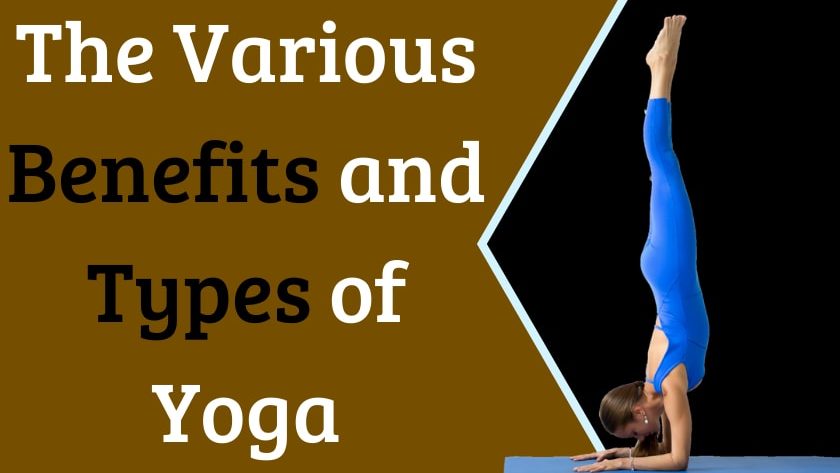In the recent past, the practice of yoga has witnessed an upsurge in popularity in the West among medical professionals and celebrities alike. While many associate yoga with new age mysticism or the latest fad at the gym, yoga is actually an ancient practice that connects the mind, body, and spirit through body poses, controlled breathing, and meditation. The practice of yoga has many health benefits associated with it, so read on to discover the many benefits of incorporating yoga in your fitness program.
“Plain and simple, yoga is the union between the body, mind, and spirit. That’s the origins of yoga and that’s how it is practiced in the East,” says Miriam Amselem, yogi of about 30 years. “It is a place of discovery and connection with your own body that encompasses balance, proper stretching techniques, breathing, meditation, centering the mind and spirit — that’s yoga in its real form.”
Types of Yoga:
There are many different types of yoga, whether you want a more physically demanding class or an easy, relaxing, meditative class. Yoga does not subscribe the “no pain, no gain” philosophy that’s the norm in fitness communities. The primary tenet is ahimsa, or non-harming, and that starts with choosing the right type of yoga for you.
Here are the 11 major types of yoga.
1. Vinyasa Yoga
Vinyasa means “to place in a special way” and, in this case refers to yoga postures. Vinyasa yoga is often considered the most athletic style of yoga. Vinyasa was adapted from ashtanga yoga in the 1980s.
How to practice:
In vinyasa, your movement is in coordination with your breath and flows from one pose to another. Vinyasa styles can vary depending on the teacher, and there can be many types of poses in different sequences.
2. Hatha yoga
The Sanskrit term “hatha” is an umbrella term for all physical postures of yoga. In the West, hatha yoga simply refers to all the other styles of yoga (ashtanga, Iyengar, etc.) that are grounded in physical practice. However, there are other branches of yoga such as kriya, raja, and karma yoga that are not based on physical movement.
How to practice:
Hatha yoga classes are suitable for beginners since they are usually paced slower than other kinds of yoga. Hatha practice today are a classic approach to breathing and exercises. If you are just starting off, hatha yoga is a great entry point into the practice.
3. Iyengar Yoga
Iyengar yoga was founded by B.K.S. Iyengar and focuses on alignment as well as detailed and precise movements. In an Iyengar class, students perform a variety of postures while controlling the breath.
How to practice:
Generally, postures are held for a long time while adjusting the minutiae of the pose. Iyengar relies heavily on props to help students perfect their form and go deeper into poses in a safe manner. You will definitely get aproactive workout and will feel open and relaxed after an Iyengar class. This style is good for people with injuries or pains, who need to work slowly and methodically.
4. Kundalini Yoga
Kundalini yoga practice is equal parts spiritual and physical. This style is all about releasing the kundalini energy in your body that is said to be trapped, or coiled, in the lower spine.
How to practice:
This type allows you to work your core and breathing with fast-moving, invigorating postures and breathing exercises. The practice is pretty intense and may involve chanting, mantra, and meditation.
5. Ashtanga yoga
In Sanskrit, ashtanga is translated as “Eight Limb Path.” In Mysore, India, people gather to practice this form of yoga together at their own pace. If you see Mysore-led ashtanga, it’s expected of you to know the series.
Vinyasa yoga stems from ashtanga as the flowing style linking breath to movement.
How to practice:
Ashtanga yoga involves a very physically demanding sequence of postures, so this style of yoga is not suitable for a beginner. It takes an experienced yogi to really cultivate it. Ashtanga starts with five sun salutation As and five sun salutation Bs and then moves into a sequence of standing and floor postures.
6. Bikram Yoga
Bikram yoga is named after Bikram Choudhury and is a sequence of poses in a sauna-like room—typically set to 105 degrees and 40% in humidity. Choudhury faced sexual assault and harassment lawsuits in the U.S. and fled to Mexico in 2017. Many studios that were formerly Bikram now practice hot yoga, in an effort to disassociate with the founder.
How to practice:
The sequence includes a series of 26 postures, and each is performed twice. Many of these poses are focused on proper alignment. If you’re interested in yoga with the heat turned up, look for studios that offer hot yoga classes.
7. Yin yoga
Yin yoga is a slow-paced style of yoga with seated postures that are held for longer periods of time. Yin can also be a meditative yoga practice that helps you find inner peace.
How to practice:
Yin is great for beginners, as postures are typically held for from 45 seconds to 2 minutes. The practice is relaxed, as you let gravity do most of the work.
8. Restorative yoga
Restorative yoga focuses on winding down after long, stressful days and relaxing your mind. This style focuses on body relaxation. Restorative yoga also helps to free and energize your mind.
How to practice:
You spend more time in perfecting fewer postures. Many of the poses are modified to be easier and more relaxing. Like Iyengar, many props are used and are placed just right such as blankets, bolsters, and eye pillows. All of the props are there to help you sink deeper into relaxation.
9. Prenatal Yoga
Prenatal yoga is carefully adapted for moms-to-be and is tailored to suit women in all trimesters. Prenatal is said to be one of the best types of exercise for expecting women because of its pelvic floor work, focus on breathing, and bonding with the growing foetus; prenatal yoga also helps mothers prepare for labor and delivery.
How to practice:
During this practice, you’ll use props in order to modify your poses and ensure stability—in this class, it’s way more about stability than flexibility.
10. Anusara Yoga
Anusara is a modern-day rendition of hatha yoga, most similar to vinyasa in that it focuses on alignment, but with more emphasis on the mind-body-heart connection. It was founded by John Friend who created a unique system called the Universal Principals of Alignment. He resigned in 2012 after accusations of sexual misconduct and financial mismanagement.
How to practice:
Anusara focuses on spirals and how each body part should move, and it’s also known for its emphasis on opening the mind.
11. Jivamukti Yoga
Jivamukti was founded in 1984 by Sharon Ganon and David Life. Jivamukti is mainly vinyasa flow-style infused with Hindu spiritual teachings. This style emphasizes connection to the Earth as a living being, so most Jivamukti devotees follow their vegetarian lifestyle.
How to practice:
A series of chants usually initiate the practice followed by a series of poses that align with the five tenets of Jivamukti yoga and philosophy.
Various Benefits of Yoga:
Physical Benefits of Yoga:
1. Improves Flexibility
One of the most popular benefits of yoga is improving flexibility. Practicing just 15–30 minutes of yoga each day could make a big difference for those looking to enhance performance by increasing flexibility and balance.
2. Builds strength
In addition to improving flexibility, yoga is a great addition to an exercise routine for its strength-building benefits. In fact, there are specific poses in yoga that are designed to increase strength and build muscle.
3. Increases Muscle Tone
Strong muscles do more than make you look good. They also protect us from conditions like arthritis and back pain, and help prevent falls in elderly people. When you build strength through yoga, you balance it with flexibility. If you just went to the gym and lifted weights, you may manage to build strength but at the expense of flexibility.
4. Improves Balance
An integral benefit of yoga practice is achieving balance and assuming gradual control over your body. With consistent practice, you will find that your overall balance will improve outside yoga class.
5. Improves Sleep Quality
Yoga, like other exercises, improves your health and helps you sleep better at night.
6. May Reduce Chronic Pain
Chronic pain is a gnawing problem that affects many people and has a range of possible causes, from injuries to arthritis. There is a growing body of research demonstrating that a benefit of practicing yoga could help to reduce and manage chronic pain.
7. A boost to weight loss and maintenance
People who practice yoga and are mindful eaters and are more in tune with their bodies. Researchers found that those practiced yoga for at least 30 minutes once a week for at least four years, gained less weight during middle adulthood.
People who were overweight lost weight. Overall, those who practiced yoga had lower body mass indexes (BMIs) compared to those who did not practice yoga. Researchers attributed this to mindfulness. Mindful eating can lead to a more positive relationship with food and eating.
Twisting poses are thought to wring out venous blood from internal organs and allow oxygenated blood to flow in once the twist is released. Thus, it improves blood flow. Yoga also has the benefit of improving breathing.
Mental Benefits of Yoga:
Practicing yoga reduces stress and relieves anxiety. Breathing exercises in yoga help facilitate reduction in anxiety. Thus, the overall well-being improves with due to the following benefits of yoga.
- Concentration: Researcher has shown that as little as eight weeks of yoga practice can result in better concentration and more motivation.
- Memory: Improved blood circulation to the brain as well as the reduction in stress and improved focus results in a better memory.
- Control and calmness: Concentrating so intently on what your body is doing has the effect of bringing calmness and making you feel in control. Yoga introduces you to meditation techniques, such as watching how you breathe and disengagement from your thoughts, which help calm the mind.
- Stress reduction: The concentration required during yoga practice tends to focus your attention on the matter at hand, thereby reducing the thoughts we invest in the stressful things in life.
- Depression: Some believe the negative feelings that we tend to repress are brought to the surface during some types of yoga exercise. When this happens, the negative energy is no longer stuck within, but is released. Regularly releasing this negativity leads to better management of depression in many people.
Emotional Benefits of Yoga:
Yoga improves your mood and helps you lead a happier lifestyle. Yoga is known to pacify the fluctuations of the mind by giving us more control. It slows down the mental loops of frustration, regret, anger, fear, and desire that can cause stress. And since stress is a leading cause so many health problems—from migraines and insomnia to lupus, MS, eczema, high blood pressure, and heart attacks—if you learn to control your mind, you’re likely to live longer and healthier.
Good yoga teachers can benefit you by doing wonders for your health. Exceptional ones do more than guide you through the postures. They adjust your posture, gauge when you should go deeper in poses or back off, deliver hard truths with compassion, help you relax, and enhance and personalize your practice. A respectful relationship with a yoga guide goes a long way towards promoting your health.
Disease Prevention from Yoga:
From lowering blood pressure to increasing pain tolerance, the following health benefits of yoga can all be discovered within the body and outside the body.
- Blood pressure: A consistent yoga practice decreases blood pressure through better circulation and oxygenation of the body. These two exercises can help lower blood pressure.
- Pulse rate: A slower pulse rate indicates that your heart is strong enough to pump more blood with fewer beats. Regularly practicing yoga provides a lower pulse rate.
- Circulation:Yoga improves blood circulation. By transporting nutrients and oxygen throughout your body, yoga practice provides healthier organs, skin, and brain.
- Respiratory: Like the circulatory system, a lower respiratory rate indicates that the lungs are working more efficiently. Yoga decreases the respiratory rate through a combination of controlled breathing exercises and better fitness.
- Health health: A combination of lower heart rate and improved oxygenation to the body (both benefits of yoga) results in unparalleled cardiovascular benefits.
- Gastrointestinal: Gastrointestinal functions have been shown to improve in both men and women who practice yoga.
- Immunity:Yoga practice has a correlation with a stronger immune system.
- Pain: Pain tolerance is much higher among those who practice yoga regularly. Aside from pain tolerance, some instances of chronic pain, such as back pain, are lessened or eliminated through the practice of yoga.
- Metabolism:Having a balanced metabolism results in maintaining a healthy weight and controlling hunger. A major benefit of consistent yoga practiceis that it helps find the balance and engineers an efficient metabolism.
- Aging: Yoga stimulates the detoxification process within the body. Detoxification has been shown to delay aging, among many other health benefits.
- Posture: The very nature of the discipline of yoga teaches the practitioner how to hold one’s body in a more healthy position. Through consistent practice, your posture will improve so that you look increasingly confident and healthy.
- Osteoporosis:It is well documented that weight-bearing exercise strengthens bones and helps prevent osteoporosis. Additionally, the benefit of yogain loweingr levels of cortisol may help keep calcium in the bones.
- Alzheimer’s Disease:A new study indicates that yoga can help elevate brain gamma-aminobutyric (GABA) levels. Low GABA levels are associated with the onset of Alzheimer’s. Meditation practiced in yoga has also been shown to slow the progress of Alzheimer’s.
- Type II Diabetes:Apart from the glucose reducing benefit of yoga, it is also an excellent source of physical exercise and stress reduction that, along with the potential in yoga to encourage insulin production in the pancreas, can help to prevent Type-II diabetes.
- Lowers Cholesterol: Yoga practice lowers cholesterol through increased blood circulation and burning fat. An integral benefit of yogacomes in the form of helping to fight harmful cholesterol levels.
Exercise Health Benefits of Yoga:
As a form of exercise, yoga offers benefits that are sometimes not easily found among other exercise regimens.
- Low risk of injury. Due to the low impact of yoga and the controlled aspect of the movements, there is a very low risk of injury during yoga practice. This is known to help those with chronic pain, injury or of old age.
- Parasympathetic Nervous System: In many forms of exercise, the sympathetic nervous system kicks in, providing you with a fight-or-flight sensation. Yoga does the opposite and stimulates the parasympathetic nervous system. The parasympathetic system lowers blood pressure and slows the pace of your breathing, which accomodates relaxation and healing.
- Muscle tone. Consistently practicing yoga leads to better muscle tone.
- Subcortex. Subcortical regions of brain are associated with well-being, and yoga is thought to dominate the subcortex rather than the cortex (where most exercise dominates).
- Reduced oxygen consumption. Yoga consumes less oxygen than traditional exercise routines, thereby allowing the body to work more efficiently.
- Breathing. With yoga, breathing is more natural and controlled during exercise. This type of breathing provides more oxygen-rich air for your body and also provides more energy with less fatigue.
- Balanced workout of opposing muscle groups. Balance is key in yoga practice. If a muscle group is worked in one direction, it will also be worked in the opposite direction to maintain balance. This balance results in better overall workout for the body.
Conclusion:
The various benefits of yoga are wide ranging and all-encompassing. The benefits surpass the physical and promote body awareness, helping us to gain control over mind and body. Yoga benefits us in the way it is more inclusive towards our threshold of pain and takes into consideration our mental well-being. These benefits go above and beyond to improve one’s quality of life. You should make it a point to introduce yoga in your fitness regime.




